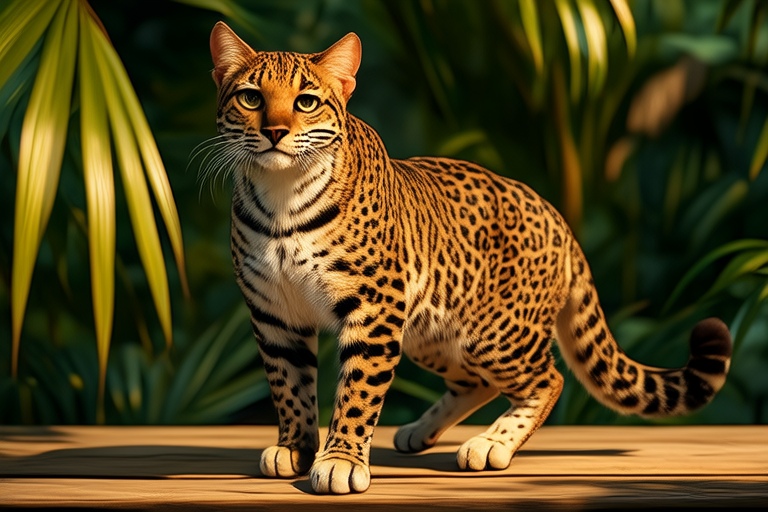From Jungle to Home: Raising a Bengal Cat Like a Pro
Bengal cats have captured the hearts of many cat lovers with their striking appearance and dynamic personalities. These felines are a crossbreed between domestic cats and Asian leopard cats, giving them a wild look that is both captivating and unique. This article will guide you through the process of raising a Bengal cat like a pro, covering everything from their origins and characteristics to essential care tips and bonding techniques.
The Origins of Bengal Cats
The story of Bengal cats began in the 1960s when breeders sought to combine the exotic beauty of the Asian leopard cat with the friendliness of domestic cats. Jean Mill, a breeder from California, was among the first to successfully develop this breed. Over time, Bengal cats have become popular pets due to their distinctive spotted or marbled coats, which resemble those of their wild ancestors.
Unique Characteristics of Bengal Cats
Bengal cats are known for their sleek, muscular bodies and vibrant coats. Their eyes are typically almond-shaped and can range from green to gold, adding to their exotic appearance. One of the most notable features of Bengal cats is their playful and energetic nature. They are intelligent, curious, and often enjoy playing fetch or climbing. This breed’s agility and athleticism make them excellent climbers and jumpers, so be prepared for your Bengal to explore every corner of your home.
Creating a Nurturing Home Environment
Providing a safe and stimulating environment is crucial for your Bengal cat’s well-being. Ensure your home is secure, especially if you have windows or balconies, as Bengals may attempt to escape. Install sturdy cat trees and provide various toys to keep your Bengal entertained. Interactive play sessions will help satisfy their need for mental stimulation and physical activity.
Dietary Needs
Bengal cats require a balanced diet rich in protein and nutrients. High-quality commercial cat food formulated for active breeds is generally sufficient. However, it’s important to consult with a veterinarian to determine the appropriate amount and type of food based on your Bengal’s age, weight, and activity level. Avoid feeding your cat human food, as certain items can be toxic to cats.
Exercise Requirements
Bengals are highly active and need plenty of opportunities to expend their energy. In addition to interactive play, consider providing puzzle feeders or treat-dispensing toys to engage their minds. Encourage climbing and jumping by setting up vertical spaces such as cat trees or shelves. Regular exercise helps maintain a healthy weight and prevents boredom-related behaviors.
Grooming Practices
Bengal cats have short, dense coats that require minimal grooming. Brushing your Bengal once or twice a week can help remove loose hair and prevent matting. Pay special attention to areas prone to shedding, such as behind the ears and under the tail. Additionally, maintaining your Bengal’s dental hygiene is essential. Brush their teeth regularly and provide chew toys to promote good oral health.
Common Health Issues
Bengal cats are generally healthy, but they may be prone to certain genetic conditions. Hypertrophic cardiomyopathy (HCM) is a heart disease that can affect Bengals, so regular veterinary check-ups are recommended. Other potential health concerns include liver disorders and skin allergies. Early detection and proper management can help address these issues effectively.
Socializing Bengal Cats
Socializing your Bengal cat from a young age is essential for building a strong relationship and ensuring they feel comfortable around people. Start by introducing your Bengal to various environments, sounds, and other animals gradually. Positive reinforcement training can also enhance your cat’s social skills and make interactions more enjoyable for both you and your pet.
Integrating Bengal Cats Into Family Life
Introducing a Bengal cat to a new family requires patience and understanding. Bengals may take some time to adjust to new surroundings and routines. Create a quiet, comfortable space for your Bengal to retreat to during the adjustment period. Encourage gentle interactions with family members and introduce other pets slowly to ensure a harmonious household.
Managing High Energy Levels and Prey Drive
Bengals’ high energy levels and strong prey drive can pose challenges for owners. To manage their energy, provide ample outlets for physical activity and mental stimulation. Interactive toys, laser pointers, and feather wands are great tools for engaging your Bengal’s natural hunting instincts. Redirecting their focus away from inappropriate targets, such as houseplants or small pets, is also important.
The Rewarding Aspects of Owning a Bengal Cat
Owning a Bengal cat can be incredibly rewarding. Their intelligence, loyalty, and affectionate nature make them wonderful companions. Bengals often form deep bonds with their owners and enjoy spending quality time together. By providing a loving, nurturing environment and meeting their specific needs, you can deepen the connection between you and your Bengal.
Deepening the Bond Between Owner and Pet
To strengthen the bond with your Bengal, engage in regular playtime and establish consistent routines. Spend time grooming your cat and offering treats as positive reinforcement. Communicate openly with your Bengal through gentle touch and soothing tones. Building trust and mutual respect will lead to a fulfilling and joyful relationship.
